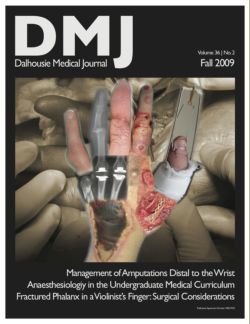Fractured phalanx in a violinist‘s finger: Special considerations in treating musician patients
DOI:
https://doi.org/10.15273/dmj.Vol36No2.3911Abstract
Post-traumatic reconstructive surgery on musician patients is uniquelchallenging in that sustained motor deficits imperceptible to the average person can be debilitating for this population.1 Instrument manipulation is extremely physically demanding; even without trauma musicians are at risk of developing a musculoskeletal disorder from mere overuse of the muscles involved in their craft.2 Furthermore, the link between physical and emotional well-being is exaggerated in musicians, as their livelihood revolves around the physical expression of emotion.3 Analyzing medical treatment from a musician‘s perspective provides a useful demonstration of the increased efficacy in utilizing a whole person approach as opposed to one that is strictly biomedical.4 Heightened sensitivity to motor deficits and the economic and emotional implications thereof are significant factors pertaining to the lifestyle of these patients, and treatment should be tailoredaccordingly.
Downloads
Published
2009-11-12
How to Cite
Gibson, J., & Williams, J. (2009). Fractured phalanx in a violinist‘s finger: Special considerations in treating musician patients. DALHOUSIE MEDICAL JOURNAL, 36(2). https://doi.org/10.15273/dmj.Vol36No2.3911
Issue
Section
Research
License
Authors who publish with this journal agree to the following terms:
- Authors retain copyright and grant the journal right of first publication with the work simultaneously licensed under a Creative Commons Attribution License that allows others to share the work with an acknowledgement of the work's authorship and initial publication in this journal.
- Authors are able to enter into separate, additional contractual arrangements for the non-exclusive distribution of the journal's published version of the work (e.g., post it to an institutional repository or publish it in a book), with an acknowledgement of its initial publication in this journal.
- Authors are permitted and encouraged to post their work online (e.g., in institutional repositories or on their website) prior to and during the submission process, as it can lead to productive exchanges, as well as earlier and greater citation of published work (See The Effect of Open Access).


